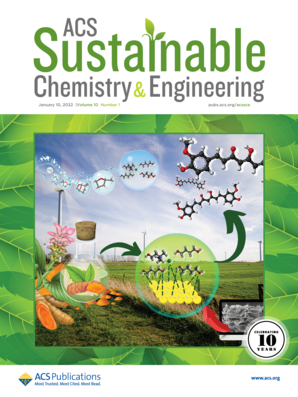碱性电解液中假晶MoSx阴极上硝基芳烃高效电催化加氢制芳胺的研究
IF 7.1
1区 化学
Q1 CHEMISTRY, MULTIDISCIPLINARY
引用次数: 0
摘要
利用水作为清洁、安全的氢源,开发一种活性富土金属电催化剂,用于芳香硝基化合物加氢制芳香胺,对精细化工的绿色合成具有重要意义。本文报道了一种新型的伪晶结构硫化钼(p-MoSx)作为电催化加氢催化剂,将硝基苯(Ph-NO2)转化为苯胺(Ph-NH2),其法拉第效率(F.E.%)为82.2%,转化率为99.6%,选择性超过99.1%,优于非晶型和结晶型MoSx催化剂。采用纯水热策略合成了p-MoSx,并将其沉积在碳布载体上,在合成过程中通过改变钼酸铵和硫脲的投料比来实现MoSx的结晶度。利用低电位沉积氢(HUPD)研究、电化学活性区(ECSA)测量和电化学阻抗谱(EIS)测试对活性来源进行的研究表明,独特的伪晶结构可以优化化学吸附氢(Hads)的形成和表面硝基的吸附。从而促进加氢步骤,从而在较宽的电位范围内提高Ph-NO2转化为Ph-NH2的高选择性效率(>95%)。此外,p-MoSx/CC电极也被发现能有效催化含有脆弱官能团的其他硝基化合物的电化学加氢,如C - X (X = F, Cl, Br)、C = O、C = C、C≡N和C≡C。本文章由计算机程序翻译,如有差异,请以英文原文为准。

Efficient Electrocatalytic Hydrogenation of Nitroaromatics into Arylamines on a Pseudocrystalline MoSx Cathode in an Alkaline Electrolyte
The development of an active Earth-abundant metal electrocatalyst for the hydrogenation of aromatic nitro compounds to aromatic amines using water as a clean and safe hydrogen source can greatly benefit the green synthesis of fine chemicals. Herein, we reported a novel pseudocrystalline structured molybdenum sulfide (p-MoSx) as a great electrocatalytic hydrogenation catalyst in converting nitrobenzene (Ph-NO2) to aniline (Ph-NH2) with a Faraday efficiency (F.E.%) of 82.2% and over 99.1% selectivity at a conversion of 99.6%, outperforming both the amorphous and crystalline MoSx catalysts. The p-MoSx was synthesized and deposited on a carbon cloth support via a hydrothermal-only strategy, where the crystallinities of the MoSx were realized by altering the feeding ratio of ammonium molybdate and thiourea during the synthetic processes. Activity origin investigations with underpotential deposition of hydrogen (HUPD) studies, electrochemical active areas (ECSA) measurements, and electrochemical impedance spectroscopy (EIS) tests revealed that the unique pseudocrystalline structure can optimize the chemisorbed hydrogen (Hads) formation and nitro group adsorption on the surface, thereby promoting the hydrogenation step and consequently improving the efficiency for converting Ph-NO2 to Ph-NH2 with high selectivity (>95%) in a broad potential range. In addition, the p-MoSx/CC electrode was also found to be efficient in catalyzing electrochemical hydrogenation of other nitro compounds containing fragile functional groups, such as C–X (X = F, Cl, Br), C═O, C═C, C≡N, and C≡C, to the corresponding aromatic amines.
求助全文
通过发布文献求助,成功后即可免费获取论文全文。
去求助
来源期刊

ACS Sustainable Chemistry & Engineering
CHEMISTRY, MULTIDISCIPLINARY-ENGINEERING, CHEMICAL
CiteScore
13.80
自引率
4.80%
发文量
1470
审稿时长
1.7 months
期刊介绍:
ACS Sustainable Chemistry & Engineering is a prestigious weekly peer-reviewed scientific journal published by the American Chemical Society. Dedicated to advancing the principles of green chemistry and green engineering, it covers a wide array of research topics including green chemistry, green engineering, biomass, alternative energy, and life cycle assessment.
The journal welcomes submissions in various formats, including Letters, Articles, Features, and Perspectives (Reviews), that address the challenges of sustainability in the chemical enterprise and contribute to the advancement of sustainable practices. Join us in shaping the future of sustainable chemistry and engineering.
 求助内容:
求助内容: 应助结果提醒方式:
应助结果提醒方式:


